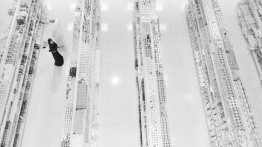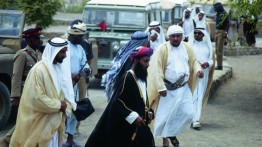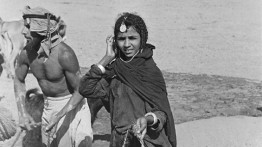The Sultanate of Oman: Geography, Religion and Culture
Thursday, March 12, 2015, 6:30 - 8:30pm
Presented by The Irwin S. Chanin School of Architecture of The Cooper Union, The Ministry of Awqaf and Religious Affairs of the Sultanate of Oman and IAV
Held in conjunction with the exhibition Three Views of Oman: The Photography of Wilfred Thesiger, Charles Butt and Edward Grazda 1945-2006, please join our distinguished scholars in a lively conversation about the interrelationship of geography, religion and culture as Oman pursues an increasingly important role in the region.
Introductory remarks by Elizabeth O’Donnell, Acting Dean, The Irwin S. Chanin School of Architecture
Panelists
Dr. Abdulrahman al-Salimi, Editor-in-Chief, Al-Tafahom, Ministry of Awqaf and Religious Affairs of the Sultanate of Oman
Mitra Abbaspour, Adjunct Professor, Faculty of Humanities and Social Sciences, The Cooper Union; Independent Scholar and Curator
Dr. Peter Kelemen, Chair, Department of Earth and Environmental Sciences, Columbia University, Lamont-Doherty Earth Observatory
Dr. Mandana Limbert, Chair, Department of Anthropology, Queens College, CUNY
Moderated by Raina Sacks Blankenhorn, Curator, Three Views of Oman
Dr. Abdulrahman al-Salimi is the Editor-in-Chief of the journal Al-Tafahom and Omani expert in ancient Islamic manuscripts. He is the author of numerous books including Early Ibadi Literature, Early Ibadi Theology, and Islamic Art in Oman. Dr. Salimi is also a professor Islamic studies at the Institute of Shariah Sciences in Muscat, and organizes the international conferences on Islamic jurisprudence that are held each year in Oman. He is also advisor to Cabinet member Sheikh Abdullah bin Mohammed al Salimi, Minister of Awqaf & Religious Affairs of the Sultanate of Oman.
Mitra Abbaspour is an independent curator and scholar based in New York. From 2010 – 2014, she was Associate Curator in the Department of Photography at The Museum of Modern Art, where she led a research initiative that drew together an international team of conservators and historians to explore the formation of photographic modernism in the twentieth century. Object:Photo. Modern Photographs from the Thomas Walther Collection 1909 – 1949 and the digital humanities platform at www.MoMA.org/objectphoto are the results of that work.
A doctoral candidate at The Graduate Center at the City University of New York, her research considers the history of photography in the Middle East and its role in defining the contemporary cultural landscape. She has authored numerous articles on contemporary photographers from Hassan Hajjaj to Shirana Shahbazi. She served as part of a curatorial team for the exhibition Re-Orientations: Islamic Art and the West in the Eighteenth and Nineteenth Centuries, which was culled from the collections of the Metropolitan Museum of Art. Before arriving in New York, Mitra was Assistant Curator and Museum Writer at UCR/California Museum of Photography. She has also taught seminars on modern and contemporary art as well as surveys of Islamic and world art at The Cooper Union, Hunter College, Brooklyn College, and the University of California, Riverside. Currently, Abbaspour is teaching a History of Photography in the Middle East course at The Cooper Union.
Peter Kelemen is the Arthur D. Storke Professor of Geochemistry at Columbia University’s Lamont Doherty Earth Observatory where he moved from the Woods Hole Oceanographic Institution in 2004. In addition to his academic work, he was a mineral exploration consultant from 1980 to 1991, evaluating deposits of copper, gold, and platinum in the steeper parts of Canada, Alaska and Greenland.
Dr. Keleman’s research interests include CO2 capture and storage via in situ mineral carbonation in peridotite and basalt; melting and reactive melt transport in the Earth's mantle and lower crust; igneous processes in forming the Earth's crust; ductile deformation and evolution of the lower crust; subduction zone geotherms and the mechanisms for intermediate depth earthquakes. Recently, he has added CO2 capture and storage via in situ mineral carbonation to his research program.
Mandana E. Limbert received her PhD in Anthropology and Near Eastern Studies from the University of Michigan in 2002 and joined the Queens College (CUNY) faculty the same year. She became a member of the faculty of the CUNY Graduate Center in 2007. She has also been a fellow and visiting scholar at The University of Michigan’s Institute for Research on Women and Gender (1999-2000), New York University’s Center for Near Eastern Studies (2000-2001), the University of California, Berkeley’s Center for Middle Eastern Studies (2001-2002), and Duke University’s Department of Cultural Anthropology (2008-2010). She joined the History department at North Carolina State University (2009-2010).
In addition to numerous articles, Professor Limbert has co-edited “Timely Assets: The Politics of Resources and their Temporalities” (2008), published by the School of American Research, Advanced Seminar Series. Her book, “In the Time of Oil: Piety, Memory, and Social Life in an Omani Town” was published by Stanford University Press (2010). And, with support of a grants from the American Council of Learned Societies and City University of New York, Professor Limbert has begun writing her next book, “Oman, Zanzibar, and the Politics of Becoming Arab” on changing notions of Arabness in Oman and Zanzibar over the course of the twentieth century.
Raina Sacks Blankenhorn is a co-founder and the Executive Vice President of the Institute for American Values, a think tank based in New York City. Since 2001, she has worked to develop an Islam-West dialogue initiative, including using photography as a way of exploring the boundaries of language, religion, and international discourse. Partnering with the Ministry of Awqaf and Religious Affairs of the Sultanate of Oman, Ms. Blankenhorn edited and curated a book and exhibition, Three Views of Oman: Society and Religion, 1945-2006, now touring the world. She has also convened an international conference with President Carter at the Carter Center in Atlanta on Islam/West engagement, sent U.S. scholars to Oman to give lectures in the Grand Mosque in Muscat, and organized a symposium on the meaning of the Arab Spring.
Free and open to the public
Photographs by Sir Wilfred Thesiger appear by permission of the Pitt Rivers Museum, University of Oxford
www.prm.ox.ac.uk
Photographs of Charles Butt appear by permission of the Middle East Centre Archive, St. Anthony’s College, Oxford, Charles Butt Collection GB165-0043
www.sant.ox.ac.uk/mec/meca.shtm1
Photographs by Edward Grazda appear by permission of the photographer and the Institute for American Values
www.americanvalues.org
Located in The Great Hall, in the Foundation Building, 7 East 7th Street, between Third and Fourth Avenues







